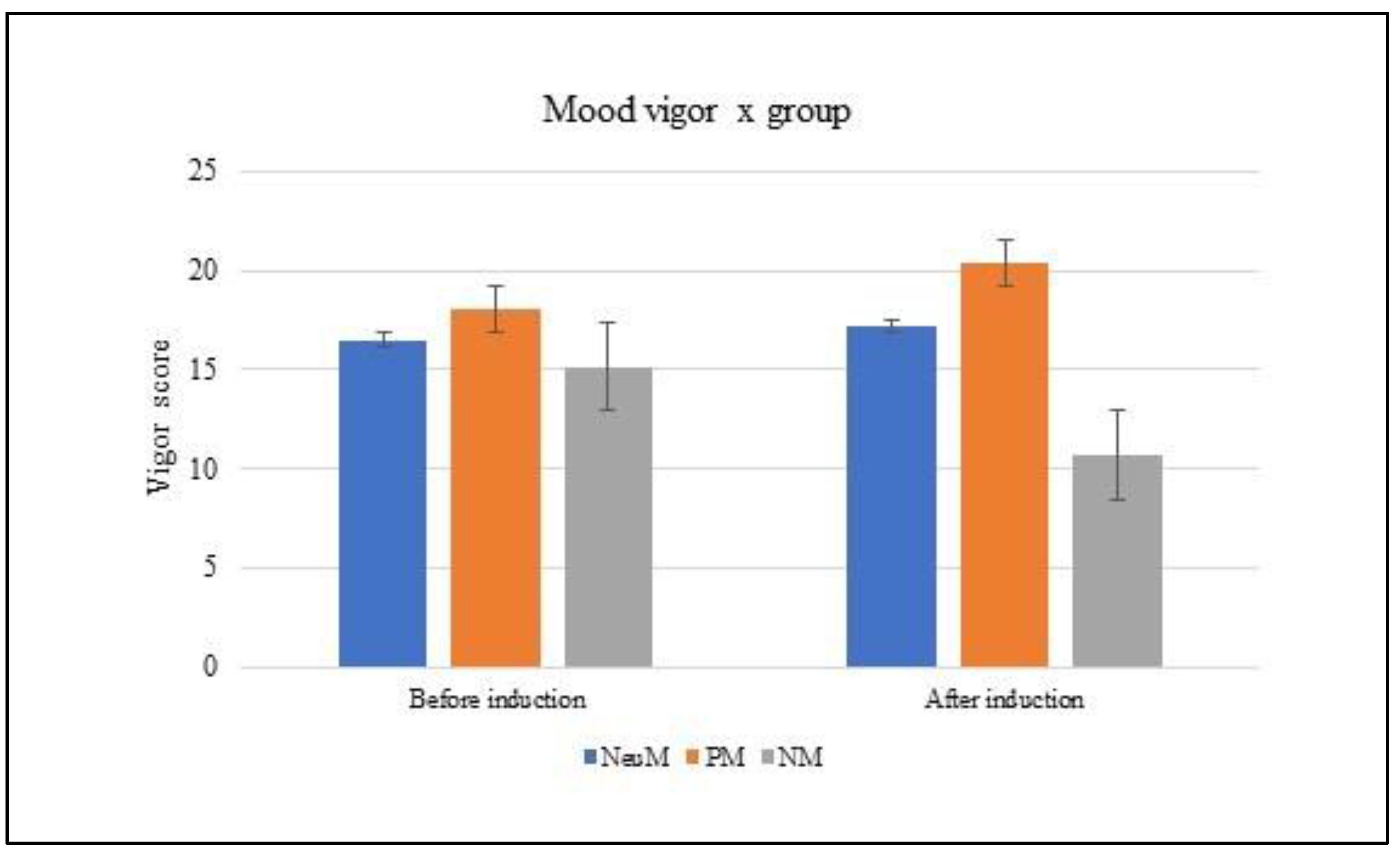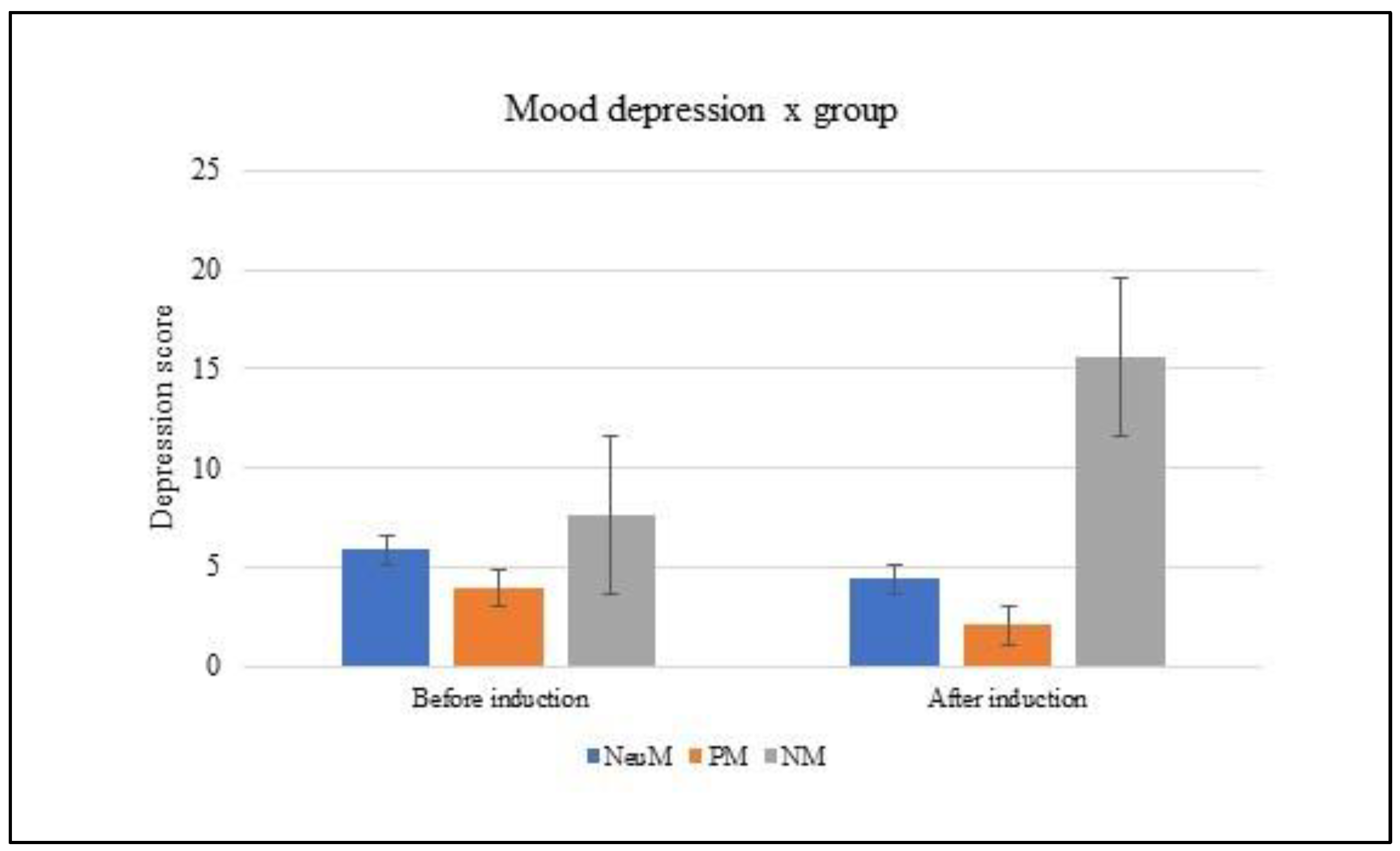The Effect of Sadness on Visual Artistic Creativity in Non-Artists
Abstract
1. Introduction
2. Materials and Methods
2.1. Participants
- -
- Positive mood group (PM), 16 females, mean age = 22.07 ± 1.95;
- -
- Negative mood group (NM), 22 females, mean age = 21.90 ± 2.26;
- -
- Neutral mood (NeuM), 17 females, mean age = 22.27 ± 2.78.
2.2. Materials
2.3. Procedure
2.4. Scoring of CDAT
2.5. Statistical Analysis
3. Results
3.1. Pre-Mood Manipulation Check
3.2. Mood Manipulation Check
3.3. Mood Effects on Creativity, Emotionality and Aesthetic Value
4. Discussion
Supplementary Materials
Author Contributions
Funding
Institutional Review Board Statement
Informed Consent Statement
Data Availability Statement
Conflicts of Interest
References
- Baas, M.; De Dreu, C.K.W.; Nijstad, A. A meta-analysis of 25 years of mood-creativity research: Hedonic tone, activation, or regulatory focus? Psychol. Bull. 2008, 134, 779–806. [Google Scholar] [CrossRef] [PubMed]
- Palmiero, M.; Piccardi, L. Frontal EEG asymmetry of mood: A mini-review. Front. Behav. Neurosci. 2017, 11, 224. [Google Scholar] [CrossRef] [PubMed]
- Beedie, C.; Terry, P.; Lane, A. Distinctions between emotion and mood. Cogn. Emot. 2005, 19, 847–878. [Google Scholar] [CrossRef]
- Lang, P.J.; Bradley, M.M.; Cuthbert, B.N. International Affective Picture System (IAPS): Affective Ratings of Pictures and Instruction Manual; Technical report A-8; University of Florida: Gainesville, FL, USA, 2008. [Google Scholar]
- Higgins, E.T. Beyond pleasure and pain. Am. Psychol. 1997, 52, 1280–1300. [Google Scholar] [CrossRef] [PubMed]
- De Dreu, C.K.; Baas, M.; Nijstad, B.A. Hedonic tone and activation level in the mood-creativity link: Toward a dual pathway to creativity model. J. Pers. Soc. Psychol. 2008, 94, 739–756. [Google Scholar] [CrossRef]
- Isen, A.M.; Shalker, T.E.; Clark, M.; Karp, L. Affect, accessibility of material in memory, and behavior: A cognitive loop? J. Pers. Soc. Psychol. 1978, 36, 1–12. [Google Scholar] [CrossRef] [PubMed]
- Isen, A.M. Positive Affect, Cognitive Processes, and Social Behavior. In Advances in Experimental Social Psychology; Berkowitz, L., Ed.; Academic Press: San Diego, CA, USA, 1987; pp. 203–253. [Google Scholar]
- Schwarz, N. Feelings as Information: Informational and Motivational Functions of Affective States. In Handbook of Motivation and Cognition: Foundations of Social Behavior; Sorrentino, R., Higgins, E.T., Eds.; Guilford Press: New York, NY, USA, 1990; pp. 527–561. [Google Scholar]
- Wegener, D.; Petty, R. Mood management across affective states: The hedonic contingency hypothesis. J. Pers. Soc. Psychol. 1994, 66, 1034–1048. [Google Scholar] [CrossRef]
- Kaufmann, G.; Vosburg, S.K. ‘Paradoxical’ mood effects on creative problem-solving. Creat. Res. J. 1997, 11, 151–170. [Google Scholar]
- Kaufmann, G.; Vosburg, S.K. Mood effects in early and late idea generation. Creat. Res. J. 2002, 14, 317–330. [Google Scholar] [CrossRef]
- George, J.M.; Zhou, J. Dual tuning in a supportive context: Joint contributions of positive mood, negative mood, and supervisory behaviours to employee creativity. Acad. Manag. J. 2007, 50, 605–622. [Google Scholar] [CrossRef]
- Abele, A. Positive and negative mood influences on creativity: Evidence for asymmetrical effects. Pol. Psychol Bull. 1992, 23, 203–221. [Google Scholar]
- Zenasni, F.; Lubart, T. Effects of mood states on creativity. Curr. Psychol. Lett. 2002, 8, 33–50. [Google Scholar] [CrossRef]
- Martin, L.L.; Ward, D.W.; Achee, J.W.; Wyer, R.S., Jr. Mood as input: People have to interpret the motivational implications of their moods. J. Pers. Soc. Psychol. 1993, 64, 317–326. [Google Scholar] [CrossRef]
- George, J.M.; Zhou, J. Understanding when bad moods foster creativity and good ones don’t: The role of context and clarity of feelings. J. Appl. Psychol. 2002, 87, 687–697. [Google Scholar] [CrossRef] [PubMed]
- Jovanovic, T.; Meinel, M.; Schrodel, S.; Voigt, K.I. The influence of affects on creativity: What do we know by now? J. Creat. Bus. Innov. 2016, 2, 46–64. [Google Scholar]
- Giancola, M.; Palmiero, M.; D’Amico, S. Exploring the interplay between fluid intelligence and creativity: The mediating role of the field-dependent-independent cognitive style. Think. Skills Creat. 2022, 45, 101047. [Google Scholar] [CrossRef]
- Silva, P.J. Another look at creativity and intelligence: Exploring higher-order models and probable confounds. Pers. Individ. Differ. 2008, 44, 1012–1021. [Google Scholar] [CrossRef]
- Giancola, M.; Palmiero, M.; Bocchi, A.; Piccardi, L.; Nori, R.; D’Amico, S. Divergent thinking in Italian elementary school children: The key role of probabilistic reasoning style. Cogn. Process. 2022, 23, 637–645. [Google Scholar] [CrossRef]
- Giancola, M.; Palmiero, M.; Piccardi, L.; D’Amico, S. The relationships between cognitive styles and creativity: The role of field dependence-independence on visual creative production. Behav. Sci. 2022, 12, 212. [Google Scholar] [CrossRef]
- Vosburg, S.K. Mood and the quantity and quality of ideas. Creat. Res. J. 1998, 11, 315–324. [Google Scholar] [CrossRef]
- Giancola, M.; Palmiero, M.; Piccardi, L.; D’Amico, S. The contribution of planning to real-world creativity: The moderating role of agreeableness. Think. Skills Creat. 2021, 41, 100890. [Google Scholar] [CrossRef]
- Giancola, M.; Palmiero, M.; D’Amico, S. Divergent but not Convergent Thinking Mediates the Trait Emotional Intelligence-Real-World Creativity Link: An Empirical Study. Creat. Res. J. 2022, 1–9. [Google Scholar] [CrossRef]
- Taylor, C.L. Creativity and mood disorder: A systematic review and meta-analysis. Perspect. Psychol. Sci. 2017, 12, 1040–1076. [Google Scholar] [CrossRef] [PubMed]
- Akinola, M.; Mendes, W.B. The dark side of creativity: Biological vulnerability and negative emotions lead to greater artistic creativity. Pers. Soc. Psychol. Bull. 2008, 34, 1677–1686. [Google Scholar] [CrossRef] [PubMed]
- Schellenberg, E.G.; Nakata, T.; Hunter, P.G.; Tamoto, S. Exposure to music and cognitive performance: Tests of children and adults. Psychol. Music 2007, 35, 5–19. [Google Scholar] [CrossRef]
- Gerrards-Hesse, A.; Spies, K.; Hesse, E.W. Experimental inductions of emotional states and their effectiveness: A review. Br. J. Psychol. 1994, 85, 55–78. [Google Scholar] [CrossRef]
- Gilet, A.L. Mood induction procedures: A critical review. L’encéphale 2008, 34, 233–239. [Google Scholar] [CrossRef]
- Palmiero, M.; Nori, R.; Rogolino, C.; D’Amico, S.; Piccardi, L. Situated navigational working memory: The role of positive mood. Cogn. Process. 2015, 16, 327–330. [Google Scholar] [CrossRef]
- Västfjäll, D. Emotion induction through music: A review of the musical mood induction procedure. Music Sci. 2001, 5, 173–211. [Google Scholar] [CrossRef]
- Carter, F.A.; Wilson, J.S.; Lawson, R.H.; Bulik, C.M. Mood induction procedure: Importance of individualising music. Behav. Chang. 1995, 12, 159–161. [Google Scholar] [CrossRef]
- Völker, J. Personalising music for more effective mood induction: Exploring activation, underlying mechanisms, emotional intelligence, and motives in mood regulation. Music Sci. 2021, 25, 380–398. [Google Scholar] [CrossRef]
- Christensen, B.T.; Ball, L.J. Dimensions of creative evaluation: Distinct design and reasoning strategies for aesthetic, functional and originality judgments. Des. Stud. 2016, 45, 116–136. [Google Scholar] [CrossRef]
- Faul, F.; Erdfelder, E.; Lang, A.G.; Buchner, A. G* Power 3: A flexible statistical power analysis program for the social, behavioral, and biomedical sciences. Behav. Res. Methods 2007, 39, 175–191. [Google Scholar] [CrossRef] [PubMed]
- He, W.J.; Wong, W.C.; Hui, A.N.N. Emotional reactions mediate the effect of music listening on creative thinking: Perspective of the arousal-and-mood hypothesis. Front. Psychol. 2017, 8, 1680. [Google Scholar] [CrossRef] [PubMed]
- Cohen, J. Statistical Power Analysis for the Behavioral Sciences, 2nd ed.; Erlbaum: Mahwah, NJ, USA, 1988. [Google Scholar]
- Clark, G.A. Screening and identifying students talented in the visual arts: Clark’s Drawing Abilities Test. Gift. Child Q. 1989, 33, 98–105. [Google Scholar] [CrossRef]
- Palmiero, M.; Nori, R.; Aloisi, V.; Ferrara, M.; Piccardi, L. Domain-specificity of creativity: A study on the relationship between visual creativity and visual mental imagery. Front. Psychol. 2015, 6, 1870. [Google Scholar] [CrossRef] [PubMed]
- McNair, D.M.; Lorr, M.; Droppleman, L.F. Manual for the Profile of Mood States; Educational and Industrial Testing Service: San Diego, CA, USA, 1971. [Google Scholar]
- Farnè, M.; Sebellico, A.; Gnugnoli, D.; Corallo, A. POMS: Profile of Mood States. Adattamento Italiano [POMS: Profile of Mood States. Italian Adaptation]; Organizzazioni Speciali: Firenze, Italy, 1991. [Google Scholar]
- McNair, D.M.; Lorr, M.; Droppleman, L.F. The Profile of Mood States; Educational and Industrial Testing Service: San Diego, CA, USA, 1992. [Google Scholar]
- Thompson, W.F.; Schellenberg, E.G.; Husain, G. Arousal, mood and the Mozart effect. Psychol. Sci. 2001, 12, 248–251. [Google Scholar] [CrossRef]
- Amabile, T.M. The social psychology of creativity: A componential conceptualization. J. Pers. Soc. Psychol. 1983, 45, 357–376. [Google Scholar] [CrossRef]
- Walker, A.M.; Koestner, R.; Hum, A. Personality correlates of depressive style in autobiographies of creative achievers. J. Creat. Behav. 1995, 29, 75–94. [Google Scholar] [CrossRef]
- Fong, C.T. The effects of emotional ambivalence on creativity. Acad. Manag. J. 2006, 49, 1016–1030. [Google Scholar] [CrossRef]
- Taruffi, L.; Koelsch, S. The paradox of music-evoked sadness: An online survey. PLoS One 2004, 9, e110490. [Google Scholar] [CrossRef] [PubMed]
- Vouskoski, J.K.; Thompson, W.F.; McIlwain, D.; Eerola, T. Who enjoys listening to sad music and way? Music Percept. 2012, 29, 311–317. [Google Scholar] [CrossRef]
- Sachs, M.E.; Damasio, A.; Habibi, A. The pleasures of sad music: A systematic review. Front. Hum. Neurosci. 2015, 9, 404. [Google Scholar] [CrossRef] [PubMed]
- Brattico, E.; Alluri, V.; Bogert, B.; Jacobsen, T.; Vartiainen, N.; Nieminen, S.; Tervaniemi, M. A functional MRI study of happy and sad emotions in music with and without lyrics. Front. Psychol. 2011, 2, 308. [Google Scholar] [CrossRef]
- Warmbrodt, A.; Timmers, R.; Kirk, R. The emotion trajectory of self-selected jazz music with lyrics: A psychophysiological perspective. Psychol. Music 2022, 50, 756–778. [Google Scholar] [CrossRef]
- Adan, A.; Guàrdia, J. Circadian variations of self-reported activation: A multidimensional approach. Chronobiologia 1993, 20, 233–244. [Google Scholar]



| PM Group | NM Group | NeuM Group | |
|---|---|---|---|
| Vigor before induction | 18.03 (5.82) | 15.17 (6.13) | 16.50 (4.22) |
| Vigor after induction | 20.40 (5.54) | 10.67 (6.58) | 17.20 (4.14) |
| Depression before induction | 4.00 (4.33) | 7.63 (7.37) | 5.90 (6.44) |
| Depression after induction | 2.10 (3.36) | 15.60 (11.58) | 4.43 (6.27) |
| Creativity | 3.70 (1.39) | 5.10 (1.91) | 3.79 (1.41) |
| Emotionality | 3.84 (1.43) | 5.37 (1.88) | 4.22 (1.43) |
| Aesthetic value | 3.66 (1.73) | 4.69 (2.00) | 3.66 (1.25) |
Disclaimer/Publisher’s Note: The statements, opinions and data contained in all publications are solely those of the individual author(s) and contributor(s) and not of MDPI and/or the editor(s). MDPI and/or the editor(s) disclaim responsibility for any injury to people or property resulting from any ideas, methods, instructions or products referred to in the content. |
© 2023 by the authors. Licensee MDPI, Basel, Switzerland. This article is an open access article distributed under the terms and conditions of the Creative Commons Attribution (CC BY) license (https://creativecommons.org/licenses/by/4.0/).
Share and Cite
Palmiero, M.; Piccardi, L.; Giancola, M.; Nori, R.; Guariglia, P. The Effect of Sadness on Visual Artistic Creativity in Non-Artists. Brain Sci. 2023, 13, 149. https://doi.org/10.3390/brainsci13010149
Palmiero M, Piccardi L, Giancola M, Nori R, Guariglia P. The Effect of Sadness on Visual Artistic Creativity in Non-Artists. Brain Sciences. 2023; 13(1):149. https://doi.org/10.3390/brainsci13010149
Chicago/Turabian StylePalmiero, Massimiliano, Laura Piccardi, Marco Giancola, Raffaella Nori, and Paola Guariglia. 2023. "The Effect of Sadness on Visual Artistic Creativity in Non-Artists" Brain Sciences 13, no. 1: 149. https://doi.org/10.3390/brainsci13010149
APA StylePalmiero, M., Piccardi, L., Giancola, M., Nori, R., & Guariglia, P. (2023). The Effect of Sadness on Visual Artistic Creativity in Non-Artists. Brain Sciences, 13(1), 149. https://doi.org/10.3390/brainsci13010149









